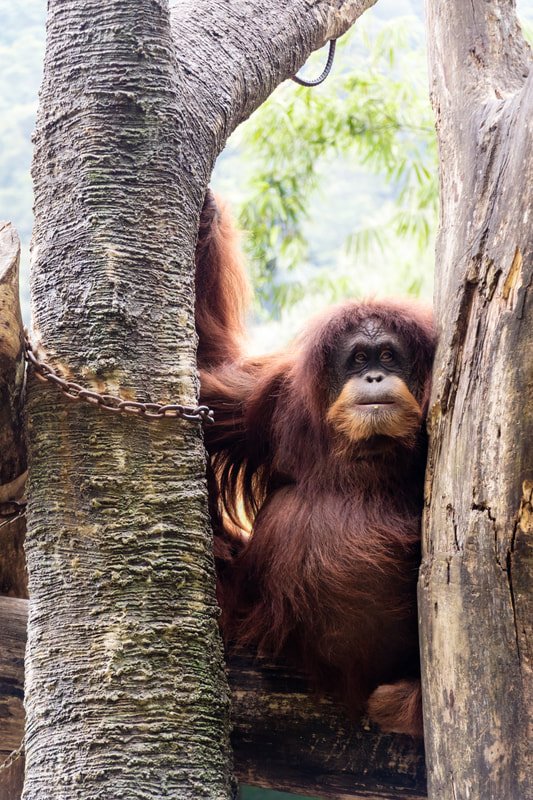
Imagine being on a nature hike, surrounded by towering trees and the sounds of birds calling. Suddenly, you spot a flash of orange fur in the treetops. Your heart races as you realize it’s a Tapanuli orangutan. But wait—not all encounters with wildlife are straightforward. Knowing how to behave in such situations can make all the difference for you and the orangutan.
In this article, we’re going to explore what you should do if you encounter a Tapanuli orangutan in the wild. From understanding their behavior to safe approaches and what to avoid, we’ll cover everything you need to know for a respectful and safe interaction with these incredible animals.
Understanding the Tapanuli Orangutan
The Tapanuli orangutan, scientifically known as *Pongo tapanuliensis*, is a fascinating species. They’re unique not just because of their rareness but also due to their distinct characteristics. With a smaller population compared to other orangutans, they are found only in a specific region of Sumatra, Indonesia. Sadly, they face serious threats from habitat loss and poaching.
You might be wondering what sets them apart from other great apes. For starters, Tapanuli orangutans are known for their shaggy, bright orange fur, which is thicker than that of their Bornean counterparts. They also have a more rounded face and a different genetic makeup, making them a distinct species. Understanding these traits is essential, especially when you’re in their territory.
It’s essential to appreciate their role in the ecosystem as well. As *keystone species*, Tapanuli orangutans contribute to the health of the rainforest, helping to disperse seeds and maintain the balance of their habitat. By learning more about them, you’ll understand why respectful encounters are crucial.
What to Do When You Spot a Tapanuli Orangutan
If you find yourself lucky enough to spot a Tapanuli orangutan in the wild, your first instinct might be to reach for your camera. However, it’s vital to remain calm and composed. Here’s a few steps you should take:
1. Stay Quiet and Still: Animals, including orangutans, can easily be startled by loud noises or sudden movements. Keeping your distance and maintaining a calm demeanor will help you observe without disturbing them.
2. Observe Their Behavior: Take a moment to watch how the orangutan is acting. Are they feeding, playing, or simply resting? Understanding their behavior helps you gauge how to proceed. If they seem relaxed, you can remain nearby, but if they display signs of distress (like vocalizations or moving away), it’s best to distance yourself.
3. Take Photos Respectfully: If you want to capture the moment, do so from a distance. Use a zoom lens if possible. This minimizes intrusion and allows you to get great shots without disturbing them.
It’s crucial to remember that these are wild animals, not pets. Your actions should reflect respect for their space and environment.
Keeping Safe During the Encounter
While Tapanuli orangutans are generally not aggressive, safety is always a priority during wildlife encounters. Here are some tips to keep both yourself and the orangutan safe:
– Maintain a Safe Distance: Ideally, you should keep at least 50 meters between you and the orangutan. This distance protects both your safety and their comfort. Getting too close can be stressful for them.
– Avoid Feeding Them: It might seem tempting to give the orangutan food, especially if they look curious. However, feeding can disrupt their natural behaviors and create dependency on humans, which isn’t good for their survival.
– Do Not Attempt to Touch or Approach: Never try to touch or get too close to an orangutan. They’re wild animals, and any sudden movement on your part may provoke a defensive reaction. Respect their space.
Always be aware of your surroundings. Occasionally, other wildlife may be present, and it’s essential to stay alert to both human and animal interactions.
Understanding Their Habitat and Role in the Ecosystem
The Tapanuli orangutan’s habitat is primarily located in the Batang Toru ecosystem. This lush area, with its high biodiversity, is vital for their survival and the health of the rainforest. Protecting their habitat ensures these incredible creatures continue to thrive.
The rainforest provides food, shelter, and space for orangutans to play and raise their young. They primarily eat fruits, leaves, and bark, and their foraging habits are crucial for seed dispersal. When they eat fruit and move around the forest, they help regenerate plant life, contributing to the overall health of their environment.
Deforestation due to logging and agricultural expansion poses a significant threat to their habitat. Knowing this, when you encounter a Tapanuli orangutan, you’re witnessing a critical piece of an ecosystem that needs our protection. Awareness of their role adds depth to your experience and reinforces the importance of conservation efforts.
How to Support Tapanuli Orangutans and Their Habitat
After learning about the Tapanuli orangutan, you might be thinking about ways to contribute to their conservation. Thankfully, there are several effective ways to support these amazing creatures:
– Support Conservation Programs: Look for organizations that work specifically toward orangutan conservation and habitat protection. Donations or volunteering can make a significant impact.
– Spread Awareness: Share your knowledge with friends or on social media. Every conversation about these orangutans raises awareness and helps protect their future.
– Choose Sustainable Products: When shopping, opt for products that support sustainably-sourced materials. This can include palm oil alternatives, as conventional palm oil farming contributes to deforestation.
Every little bit counts. By taking action, you help ensure that future generations will have the opportunity to see Tapanuli orangutans in the wild.
Final Thoughts: Respecting Wildlife Encounters
Encountering a Tapanuli orangutan in the wild is a rare and magical experience. It allows you to appreciate nature’s beauty and understand the importance of protecting these incredible animals. By staying calm, maintaining a safe distance, and observing their natural behaviors, you contribute to their well-being and the health of their habitat.
Ultimately, the goal of such encounters should be to deepen our understanding of wildlife and nurture a sense of responsibility toward conservation. So, the next time you find yourself in the wild, remember these tips and embrace the wonder of nature—while respecting the creatures that call it home.

